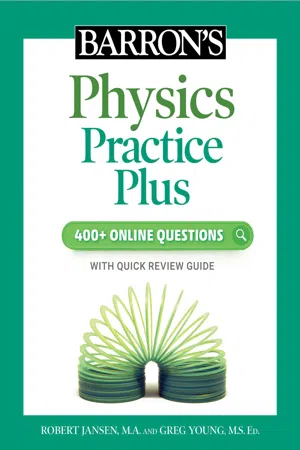Physics
Free Body Diagrams
Free body diagrams are visual representations used to analyze forces acting on an object. They isolate the object of interest and show all the forces acting on it, including magnitude, direction, and type. By using free body diagrams, physicists can better understand the forces at play in a given situation and make predictions about the object's motion.
Written by Perlego with AI-assistance
Related key terms
Related key terms
1 of 4
Related key terms
1 of 3
4 Key excerpts on "Free Body Diagrams"
- Robert Jansen, Greg Young(Authors)
- 2022(Publication Date)
- Barrons Educational Services(Publisher)
x is the distance the spring is either stretched or compressed (units: m). Every spring has its own unique spring constant. Finding the spring constant, if it is not given, is often the first critical step in solving spring problems.Force DiagramsThe first step in solving a dynamics problem is to identify all forces, including the direction of each force, acting on an object. This can be accomplished by constructing a force diagram, known as a free-body diagram. A free-body diagram includes only the object and the forces acting on the object. It is free of clutter and does not include surfaces, strings, springs, or any other agents acting on the object. A free-body diagram serves two key purposes: First, it allows you to visualize how the forces will influence the motion. Second, it provides a frame of reference in which to work with the force vectors.EXAMPLE 5.1Free-Body Diagrams A 10-kilogram mass is pulled at constant velocity to the right along a rough horizontal surface by a string. Construct a free-body diagram depicting all the forces acting on the mass. WHAT’S THE TRICK? Identify all the forces acting on the mass.•Gravity is not mentioned in the problem. Unless specified otherwise, problems take place on Earth, so the force of gravity, Fg , is present.•You may be able to deduce some forces from the diagram. Both a string and a surface are in contact with the object. Therefore, tension, T, and the normal force, N, are present.•Identifying other forces requires you to read the text of the problem. This problem mentions a “rough” surface, implying that friction, f, is present.The resulting free-body diagram is shown below left. Free-body diagrams are nearly identical to plotting vectors on coordinate axes, as shown below right.- eBook - ePub
Introductory Physics
Summaries, Examples, and Practice Problems
- Michael Antosh(Author)
- 2023(Publication Date)
- CRC Press(Publisher)
Specific Types of Forces, and Force ProblemsDOI: 10.1201/9781003005049-55.1 Introduction: There are Different Types of Forces
There are many different types of forces in the world. In this chapter, we’ll look at the types of forces that are most commonly discussed in introductory physics courses, as well as looking at three specific types of force problems. But before that, we need to talk about the very useful topic of Free Body Diagrams.5.2 Free Body Diagrams
A free body diagram is a very useful tool to help you do physics problems. For each object in a given problem, making a free body diagram is as simple as this:- Draw something to represent each object in the problem. Usually there is only one object; occasionally there are two or three in a complicated problem. Tipler’s text (cited in the acknowledgements) suggests using just a dot instead of drawing a full picture.
- Set a coordinate system, similar to what we talked about earlier in the textbook, for example in Chapters 2 and 3 . For each dimension (likely two dimensions, but possibly one for specific problems), have a positive direction. Most often, “to the right” or “east” can be positive x, and “up” or “north” can be positive y.
- Spend some time thinking about what forces are on the object. For every force that you think is on the object, draw that force. Label it with the amount of force (magnitude), and draw it in the direction it is going.
- Sometimes you may not know the magnitude or direction of a force; in that case you can give that force two components (one in the + x direction and one in the +y direction) and figure out later what those forces are.
Once a correct free body diagram is made, it’s easy to add up the forces in the x and y directions. Remember from Chapter 4 - eBook - ePub
Analysis of Structures
An Introduction Including Numerical Methods
- Joe G. Eisley, Antony M. Waas(Authors)
- 2011(Publication Date)
- Wiley(Publisher)
In the case of a statically indeterminate body we must introduce additional equations to obtain a solution. In this chapter we shall be interested primarily in statically determinate bodies. The subsequent chapters will contend with both statically determinate and statically indeterminate problems.2.2 Free Body DiagramsWe shall illustrate each subcase with a simple example in two dimensions using concentrated forces only. In these examples it is assumed that the applied forces initially are known and the restraint forces are unknown.Consider the rigid body shown in Figure 2.2.1 . We introduce some common symbols to illustrate forces and restraints. For now we consider only concentrated loads and, in this case, assume they act entirely in the xy plane. We add concentrated restraints. The restraint on the lower left prevents movement in both the x and y directions but does allow rotation about the z axis. The restraint on the lower right prevents movement only in the y direction, since it is assumed to roll freely (without friction) in the x direction. Since it is assumed that there are no forces in the z direction there is no need to consider restraints in the z direction.Figure 2.2.1By replacing the restraint symbols in Figure 2.2.1 with visual representations of the characteristics to which we have assigned them, we create what is called a free body diagram. We draw the free body in Figure 2.2.2 showing all the applied forces and restraint forces. Unless otherwise stated we shall use the symbol F for concentrated applied forces and R for concentrated restraint forces. Appropriate subscripts will be added to identify individual forces and components. It is common to represent both the applied forces and the restraint forces in terms of their components in the appropriate coordinate directions. For the applied forces these components are(2.2.1)Figure 2.2.2According to standard sign convention, restraint force components generally are drawn directed along the positive x and y - eBook - ePub
Doing Physics with Scientific Notebook
A Problem Solving Approach
- Joseph Gallant(Author)
- 2012(Publication Date)
- Wiley(Publisher)
Eqs. (5.3) .Suppose you pull a sled with a rope across an ice surface slippery enough that we can ignore friction. There are three forces acting on the sled: your pull (P), the sled’s weight (mg), and the normal force (N). The pull force makes an angle θ to the horizontal. The FBD of the sled looks like this:Since the pull force P does not point along either axis, we must resolve it into its x- and y-components. The FBD now looks like this:With the help of the FBD and Eqs. (5.3) , the 2nd Law force equations arewhere Px = P cos θ and Py = P sin θ. There are 4 arrows in the FBD and there are 4 terms to the right of the equal signs. We set ay = 0 because the sled slides along the ice surface so its vertical velocity is constant (zero).Here is a summary of the problem-solving strategy using Newton’s 2nd Law.- Isolate the object the forces are acting on.
- Use a Free-Body Diagram to sketch the forces!
- Choose a convenient coordinate system.For example, you might pick the x-direction along the object’s motion.
- Resolve the forces into components along the x-axis and y-axis.
- Apply Newton’s 2nd Law using Eqs. (5.3) .
Example 5.2Going up!A 65 kg physics student gets on an elevator with a built-in floor scale. As the elevator accelerates upward, the tension in the supporting cable is 9500 N. As the elevator slows to a stop on the top floor, the tension in the supporting cable is 7000 N. The combined mass of the student and elevator is 850 kg. What does the scale read while the elevator is speeding up, slowing down, and moving at constant speed? What is the tension in the supporting cable while the elevator is moving at constant speed?Solution.Construct two Free-Body Diagrams, one for the student and one for the elevator. The forces in this problem all act vertically. The Tension (T) in the cable supports the elevator, which has weight Mg. The Normal force (N) supports the student, who has weight mg
Index pages curate the most relevant extracts from our library of academic textbooks. They’ve been created using an in-house natural language model (NLM), each adding context and meaning to key research topics.
Explore more topic indexes
Explore more topic indexes
1 of 6
Explore more topic indexes
1 of 4



